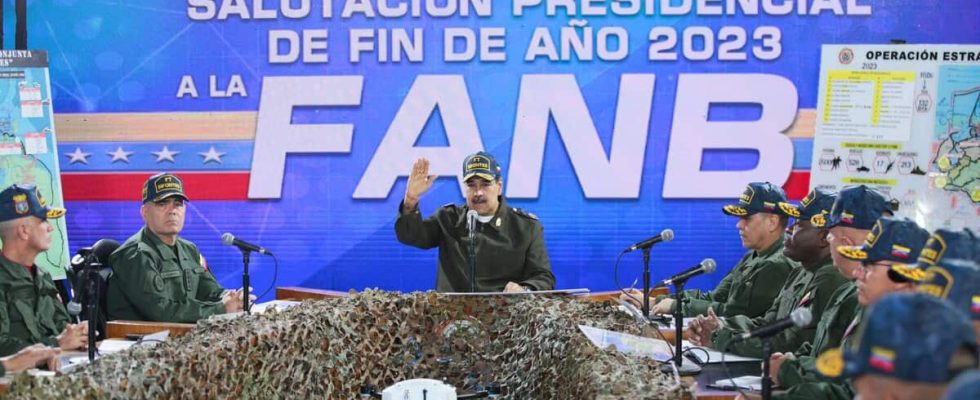The Venezuelan president launched military exercises on Thursday with some 5,600 soldiers in Guyana’s border area in “response to the provocation” of the United Kingdom, which sent a warship to Guyana in the midst of the crisis on the Essequibo.
• Read also: Migration: Washington and Mexico consider Blinken’s emergency visit fruitful
• Read also: Venezuela: rapper Canserbero was murdered, according to a new investigation eight years after his death
• Read also: The influx of migrants at the border with Mexico weakens the position of the Biden administration
“I ordered the activation of a joint action of all the Bolivarian (Venezuelan) National Armed Forces in the Eastern Caribbean, on the Atlantic coast, a joint action of a defensive nature, in response to the provocation and threat of United Kingdom against the peace and sovereignty of our country,” President Maduro said during a radio and television broadcast, in which he showed images of warships and fighter jets on patrol.
The British patrol vessel, ‘HMS Trent’, will arrive in Guyana on Friday and is scheduled to participate in military exercises in Guyanese waters for ‘less than a week’. It is not planned for it to dock in Georgetown, a Guyanese Foreign Affairs source stressed.
The HMS Trent, usually based in the Mediterranean, was sent to the Caribbean at the beginning of December to fight drug trafficking.
In a statement, the Venezuelan government had “categorically rejected the arrival of the ship (…) which constitutes an act of hostile provocation”.
“HMS Trent” | Capture taken from the British Royal Navy website
“The presence of this military vessel is extremely serious”, which is why “Venezuela urges the Guyanese authorities to take immediate steps for the withdrawal of HMS Trent, and to refrain from further involving military powers in the dispute territorial,” adds the text.
Tension rose after the launch of oil tenders by Guyana in September, then the referendum organized in response on December 3 in Venezuela on the annexation of the Essequibo, a territory of 160,000 km2 rich in oil and natural resources, administered by Georgetown and claimed by Venezuela.

AFP
Some 125,000 people, or a fifth of Guyana’s population, live in Essequibo, which covers two-thirds of the country’s land area.
Venezuela maintains that the Essequibo River should be the natural border, as in 1777 during the time of the Spanish Empire. Guyana argues that the border, dating from the English colonial era, was ratified in 1899 by an arbitration court in Paris.
Guyanese President Irfaan Ali and Venezuelan President Nicolas Maduro met on December 15 at a summit that helped ease the pressure — a commitment not to use force — but did not resolve the dispute. the two countries sticking to their positions.
According to Mr. Maduro’s broadcast, the first phase of the Venezuelan military exercises included 5,682 fighters with F-16 (American) and Sukhoi (Russian) warplanes patrolling the area.
The United Kingdom, the former colonial power, had already shown its support by sending its Secretary of State for the Americas, David Rutley, there on December 18.
Some 5,600 Venezuelan soldiers are participating in military maneuvers of a “defensive” nature ordered Thursday by President Nicolas Maduro in “response to the provocation and threat from the United Kingdom”, which sent a warship to Guyana in the midst of a crisis on the Essequibo.
“I ordered the activation of a joint action of all the Bolivarian (Venezuelan) National Armed Forces in the Eastern Caribbean, on the Atlantic coast, a joint action of a defensive nature, in response to the provocation and threat of United Kingdom against the peace and sovereignty of our country,” President Maduro said during a radio and television broadcast, in which he showed images of warships and fighter planes patrolling the area.
